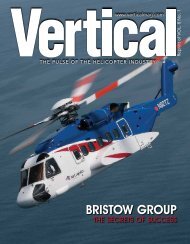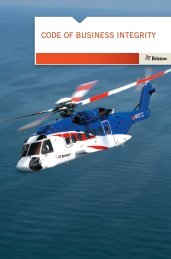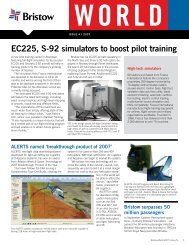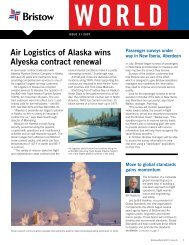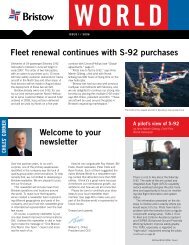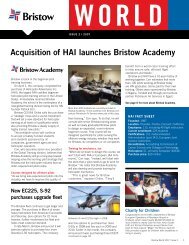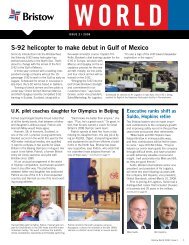BRISTOW WORLD
BRISTOW WORLD
BRISTOW WORLD
- No tags were found...
You also want an ePaper? Increase the reach of your titles
YUMPU automatically turns print PDFs into web optimized ePapers that Google loves.
By the time this nightly maintenanceprogram is drawing to a close, it is almosttime to begin the pre-flight engineeringchecks before a new day of flying can begin.Between flights, an extensive check is carried out on the Health andUsage Monitoring System (HUMS). HUMS is an airborne data-gatheringsystem which provides flight and ground crew with advanced warning of anyimpending problems. Any abnormalities would be immediately investigated,and an aircraft is never allowed to fly again until it has a clean bill of health.During flight, aircraft are monitored on a system called SKYCONNECT.This satellite tracking system is used on the vast majority of Bristow flights,and it provides a second set of eyes to make sure the flight is proceedingaccording to plan. Flight crews also have a phone in the cockpit allowingthem to speak to their base should that become necessary.This flight and maintenance cycle typically takes place three or fourtimes a day for each of the Bristow aircraft based at Aberdeen.1900 - 2000With flying over for the day, each helicopter is parked on the ramp foressential cleaning. First, the engines are kept running and treated with achemical compressor wash which removes all the sulphur and salt that hasgathered during flight time. Engine life is greatly preserved by carrying outthis task daily.Next is the skin wash, which is quite simply like a warm, soapy bath forthe helicopter’s exterior. Inside, the cabin is cleaned in preparation for thenext day’s passengers. After washing, the helicopters are returned to thehangar for a busy night of maintenance.2000 - 0400Licensed helicopter engineers now take over for the night shift and beginwith mandatory daily inspections, all of which comply with the helicoptermanufacturer’s maintenance program. These checks take at least threehours to complete for each helicopter and sometimes comprise hundredsof inspections.Every helicopter operator has to meet the manufacturer’s maintenanceprogram in an approved way – everything is audited regularly by the U.K.Civil Aviation Authority. Once these essential daily inspections have beencompleted, the engineers rectify any problems that may have arisen duringthe day’s operation.The remainder of the night is devoted to scheduled maintenance. Muchlike a car needing its 12,000-mile service, helicopters require maintenanceon either a calendar basis, the number of flying hours or the number offlights undertaken.Equipment is replaced, inspections completed (often multiple times inthe case of critical systems), maintenance records are signed and countersigned,paperwork audited and tools logged in and out of the tool controlsystem to make sure nothing is left on the aircraft that shouldn’t be there.By the time this nightly maintenance program is drawing to a close, it isalmost time to begin the pre-flight engineering checks before a new day offlying can begin.Bristow World 2008 / Issue 5II5



